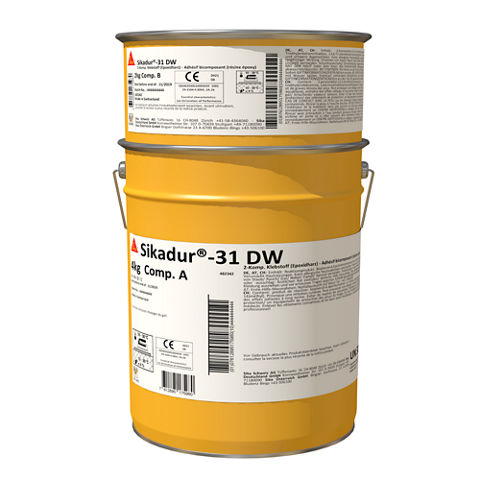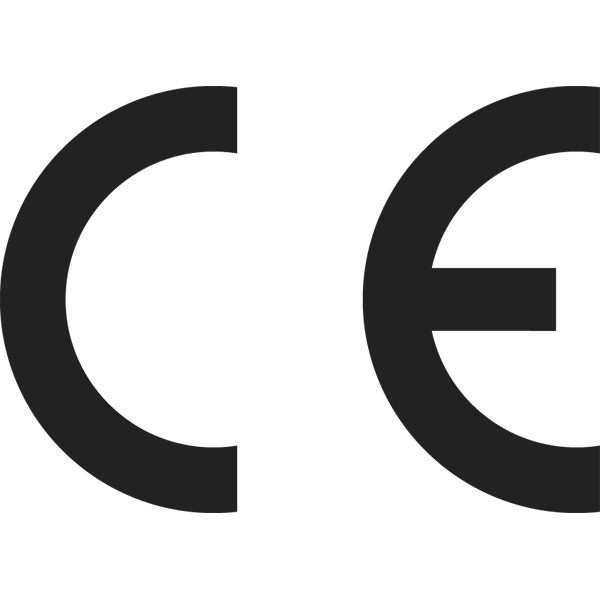
Sikadur®-31 DW
Epoxy structural adhesive approved for contact with drinking water
Sikadur®-31 DW is a two-part, epoxy, moisture-tolerant structural adhesive. It is used for bonding many construction materials and for minor concrete repairs, joint filling, and crack sealing.
- Approved for contact with drinking water.
- Easy to mix and apply.
- Very good adhesion to many construction materials.
- Very good mechanical strength.
- Hardens without shrinkage.
- Thixotropic: non-sag in vertical and overhead applications.
- Differently coloured components for mixing control.
- No primer required.
- Good resistance to abrasion.
- Impermeable to liquids and water vapour.
- Good resistance to specific chemicals.

Usage
The Product is used for bonding the following materials:- Concrete.
- Natural stone.
- Ceramics.
- Fibre cement.
- Mortar.
- Brick masonry.
- Brick slips.
- Steel.
- Iron.
- Wood.
- Glass.
- Sikadur-Combiflex® SG System for drinking water applications.
- Corners and edges.
- Holes.
- Voids.
- Metal profiles.
- Joint arrises.
- Crack arrises.
- Non-structural static cracks.
Advantages
- Approved for contact with drinking water.
- Easy to mix and apply.
- Very good adhesion to many construction materials.
- Very good mechanical strength.
- Hardens without shrinkage.
- Thixotropic: non-sag in vertical and overhead applications.
- Differently coloured components for mixing control.
- No primer required.
- Good resistance to abrasion.
- Impermeable to liquids and water vapour.
- Good resistance to specific chemicals.
Packaging
Parts A+B pre-batched unit | 6 kg container |
Refer to the current price list for available packaging variations.
Colour
Part A | White |
Part B | Dark grey |
Part A+B mixed | Concrete grey |
Product Details
ENVIRONMENTAL INFORMATION
-
Contributes towards satisfying Materials and Resources (MR) Credit: Building product disclosure and optimization — Environmental Product Declarations under LEED® v4.
-
Contributes towards satisfying Materials and Resources (MR) Credit: Building Product Disclosure and Optimization — Material Ingredients under LEED® v4.
-
Environmental Product Declaration (EPD) in accordance with EN 15804. EPD independently verified by Institut für Bauen und Umwelt e.V. (IBU).
APPROVALS / STANDARDS
- CE marking and declaration of performance based on EN 1504-4:2004 Products and systems for the protection and repair of concrete structures — Structural bonding.
- Water Regulations Sikadur Combiflex SG Jointing System, using Sikadur 31DW, Approval No. DWI 56.4.94.
-
Adhesive for Waterproofing System ÖNORM B 5014 Test 1, Sikadur®-31 DW, OFI Techn.
-
Migration Analysis RD 118/2003, Sikadur®-31 DW, O.T.E.C., Test report No. 0761415488.
-
Drinking water approval ASC, CARSO.
Product Declaration
EN 1504-4: Structural bonding
Chemical Base
Epoxy resin and selected fillers
Shelf Life
24 months from date of production
Storage Conditions
The Product must be stored in original, unopened and undamaged sealed packaging in dry conditions at temperatures between +5 °C and +30 °C. Always refer to packaging.
Refer to the current Safety Data Sheet for information on safe handling and storage.
Density
Mixed resin at +20 °C | (2.00 ± 0.1) kg/l |
System Structure
Refer to the Sikadur-Combiflex® SG System product data sheet.
Compressive Strength
| Cured 14 days at +23 °C | ~78 N/mm2 |
Flexural Strength
| Cured 14 days at +23 °C | ~37 N/mm2 |
Tensile Strength
| Cured 14 days at +23 °C | ~23 N/mm2 |
Tensile adhesion strength
Curing Time | Substrate | Curing Temperature | Adhesion strength |
7 days | Concrete dry | +23 °C | ≥ 4.5 N/mm2 (100 % concrete failure) |
7 days | Concrete moist | +23 °C | ≥ 4.5 N/mm2 (100 % concrete failure) |
7 days | Steel sandblasted | +23 °C | 9 N/mm2 |
Shrinkage
Hardens without shrinkage
Coefficient of Thermal Expansion
(2.36 × 10-5 ± 0.2 × 10-5) 1/K Linear expansion between +23 °C and +60 °C | (EN 1770) |
Heat deflection temperature
Curing time | Curing temperature | HDT |
7 days | +23 °C | +50 °C |
Chemical Resistance
Resistant to many chemicals. Contact Sika Technical Services for additional information.
Application
Mixing Ratio
Part A : Part B | 3 : 1 by weight or volume |
Layer Thickness
30 mm maximum
For non-structural adhesive or other applications, if layer thicknesses of >30 mm are required, apply in successive 30 mm layers, once the previous layer has hardened. The surface of the freshly applied intermediate layers should be scratched to form a key for subsequent layers. If layer application is to be longer than 2 days, the wet applied adhesive must be blinded to excess with quartz sand immediately after application.
Sag Flow
Non-sag up to 10 mm thickness on vertical surfaces | (EN 1799) |
Product Temperature
Maximum | +30 °C |
Minimum | +10 °C |
Ambient Air Temperature
Maximum | +30 °C |
Minimum | +10 °C |
Dew Point
Beware of condensation.
Substrate temperature during application must be at least +3 °C above dew point.
Substrate Temperature
Maximum | +30 °C |
Minimum | +10 °C |
Substrate Moisture Content
Substrates must be dry or matt damp (no standing water).
Pot Life
Temperature | Pot life 200 g | Open times |
+23 °C | 105 minutes | - |
+30 °C | - | 45 minutes |
Consumption
~2.0 kg/m2 per mm of thickness
This figure is theoretical and does not allow for any additional material due to surface porosity, surface profile, variations in level or wastage, etc.
SUBSTRATE QUALITY
CONCRETE, MASONRY, MORTAR, STONE
Concrete and mortar must be at least 28 days old.
Substrates must be sound, clean, dry or matt damp but free of standing water. Substrates must be free of contaminants such as ice, dirt, oil, grease, coatings, laitance, efflorescence, surface treatments and loose friable material.
STEEL
Surfaces must be sound, clean, dry and free of contaminants such as dirt, oil, grease, coatings and loose friable material.
WOOD
Surfaces must be sound, clean, dry and free of contaminants such as dirt, oil, grease, coatings and loose friable material.
SUBSTRATE PREPARATION
Surface contaminants such as dust and loose material, including the contaminants generated during substrate preparation, can reduce the Product's performance.
Before applying the Product, clean thoroughly all substrate surfaces using vacuum or dust removal equipment.
CONCRETE, MASONRY, MORTAR OR STONE
Suitable techniques for substrate preparation include the following:
-
Abrasive blast cleaning
-
Needle gunning
-
Light scabbling
-
Bush hammering
-
Grinding
Prepare the substrate mechanically using a suitable technique giving the substrate has an open-textured, gripping surface profile.
STEEL
Suitable techniques for substrate preparation include the following:
-
Abrasive blast cleaning
-
Rotating wire brush
-
Grinding
Prepare the substrate mechanically using a suitable technique giving the substrate a bright metal finish with a surface profile to satisfy the necessary tensile adhesion strength requirement.
WOOD
Prepare the substrate by planing, sanding or using other suitable equipment.
MIXING
When using multiple units during application, do not mix the following unit until the previous unit has been used.
PRE-BATCHED UNITS
Mix full units only. Prior to mixing all parts, mix part A (resin) briefly using a mixing spindle attached to a slow-speed electric mixer (max. 300 rpm).
Add part A to part B (hardener) and mix parts A+B continuously for at least 3 minutes until a uniformly coloured smooth consistency mix has been achieved.
Do not overmix. To ensure thorough mixing, pour materials into a clean container and mix again for approximately 1 minute. Mixing time for A+B = 4 minutes.
APPLICATION
IMPORTANT
Damage due to unsupported heavy components applied vertically or overhead
Full adhesion is not achieved before the Product has fully hardened. Hardening depends on ambient temperatures. Unsupported heavy components might fall down when not supported.
Provide temporary support for heavy components until the Product has fully hardened.
BONDING
Prior to application confirm dew point conditions before and during application.
On damp prepared concrete substrates, always apply the Product by brush and work the Product well into the substrate. Apply the mixed adhesive to the prepared surfaces with a spatula, trowel, notched trowel or by gloved hand.
For optimum adhesion apply the adhesive to both surfaces that require bonding.
For heavy components positioned vertically or overhead, provide temporary support until the Product has fully hardened.
REPAIR
Prior to application confirm dew point conditions before and during application.
On damp prepared concrete substrates, always apply the Product by brush and work the Product well into the substrate. Apply the mixed adhesive to the prepared surfaces with a spatula, trowel or by gloved hand.
JOINT FILLING AND CRACK SEALING
Apply the mixed adhesive to the prepared surfaces with a spatula or trowel.
CLEANING OF TOOLS
Clean all tools and application equipment with Sika® Thinner C immediately after use. Hardened material can only be removed mechanically.
